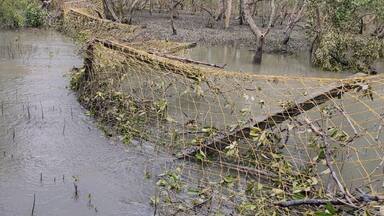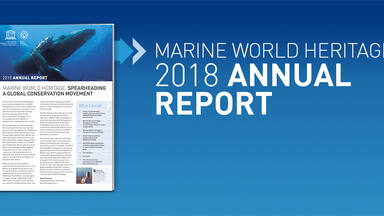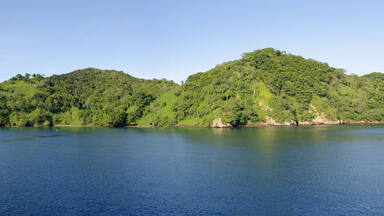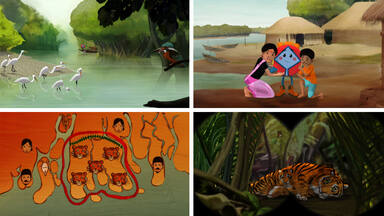Sundarbans National Park
Sundarbans National Park
The Sundarbans covers 10,000 km2 of land and water (more than half of it in India, the rest in Bangladesh) in the Ganges delta. It contains the world's largest area of mangrove forests. A number of rare or endangered species live in the park, including tigers, aquatic mammals, birds and reptiles.
Description is available under license CC-BY-SA IGO 3.0
Parc national des Sundarbans
Les Sundarbans couvrent 10 000 km2 de terre et d'eau (dont plus de la moitié en Inde, le reste au Bangladesh) dans le delta du Gange. On y trouve la plus grande région de forêts de mangroves du monde. Plusieurs espèces rares ou menacées vivent dans le parc, dont des tigres, des mammifères aquatiques, des oiseaux et des reptiles.
Description is available under license CC-BY-SA IGO 3.0
منتزه سنداربنس الوطني
يغطّي منتزه سنداربنس مساحة 10000 كيلومتر مربع من الأرض والمياه (يوجد أكثر من نصفه في الهند والباقي في بنغلاديش) في دلتا الغانج. وتتوافر في المنتزه أكبر منطقة من الغابات المنغروفية في العالم. وتعيش في هذا المنتزه أجناس عدّة نادرة أو مهددة يُذكر بينها نمور وثدييات مائية وعصافير وزواحف.
source: UNESCO/CPE
Description is available under license CC-BY-SA IGO 3.0
孙德尔本斯国家公园
孙德尔本斯位于恒河三角洲,占据10 000平方公里的陆地和水域(其中一半以上地区在印度,其余部分在孟加拉国)。这里有世界上最大的红树林区。公园内生活着许多稀有或濒危动物,其中包括老虎、水生哺乳动物、鸟类和爬行动物。
source: UNESCO/CPE
Description is available under license CC-BY-SA IGO 3.0
Национальный парк Сундарбан
Общая площадь района Сундарбан, как называется внешняя часть общей дельты рек Ганг, Брахмапутра и Мегхна, составляет около 1 млн. га. Более половины этих водно-болотных угодий приходится на территорию Индии, а остальные располагаются в Бангладеш. Здесь произрастают самые обширные мангровые заросли в мире. В парке обитает целый ряд редких и исчезающих видов животных, среди которых – бенгальские тигры, а также некоторые водные млекопитающие, птицы и рептилии.
source: UNESCO/CPE
Description is available under license CC-BY-SA IGO 3.0
Parque Nacional de los Sundarbans
Situada en el delta del Ganges, la región de los Sundarbans abarca 10.000 km² de tierra y agua. La mitad de esa superficie se halla en el territorio de la India y el resto en Bangladesh. El sitio posee la más vasta extensión de bosques de manglares del mundo y es el hábitat de diversas especies raras o en peligro de extinción: tigres, mamíferos acuáticos, aves y reptiles.
source: UNESCO/CPE
Description is available under license CC-BY-SA IGO 3.0
スンダルバンス国立公園
source: NFUAJ
De Sundarbans
Source: unesco.nl
सुंदरबन राष्ट्रीय उद्यान
सुंदरबन गंगा डेल्टा की 10,000 वर्ग किमी भूमि और जल क्षेत्र (आधे से अधिक भारत में, शेष बांग्लादेश में) में फैला है। इसमें मैंग्रोव वनों का दुनिया का सबसे बड़ा क्षेत्र शामिल है। इस उद्यान में बाघों, जलीय स्तनपायी, पक्षियों और सरीसृपों सहित कई दुर्लभ या लुप्तप्राय प्रजातियां पाई जाती हैं।
Source: India
Outstanding Universal Value
Brief synthesis
The Sundarbans contain the world's largest mangrove forests and one of the most biologically productive of all natural ecosystems. Located at the mouth of the Ganges and Brahmaputra Rivers between India and Bangladesh, its forest and waterways support a wide range of' fauna including a number of species threatened with extinction. The mangrove habitat supports the single largest population of tigers in the world which have adapted to an almost amphibious life, being capable of swimming for long distances and feeding on fish, crab and water monitor lizards. They are also renowned for being “man-eaters”, most probably due to their relatively high frequency of encounters with local people.
The islands are also of great economic importance as a storm barrier, shore stabiliser, nutrient and sediment trap, a source of timber and natural resources, and support a wide variety of aquatic, benthic and terrestrial organisms. They are an excellent example of the ecological processes of monsoon rain flooding, delta formation, tidal influence and plant colonisation. Covering 133,010 ha, the area is estimated to comprise about 55% forest land and 45% wetlands in the form of tidal rivers, creeks, canals and vast estuarine mouths of the river. About 66% of the entire mangrove forest area is estimated to occur in Bangladesh, with the remaining 34% in India.
Criterion (ix): The Sundarbans is the largest area of mangrove forest in the world and the only one that is inhabited by the tiger. The land area in the Sundarbans is constantly being changed, moulded and shaped by the action of the tides, with erosion processes more prominent along estuaries and deposition processes along the banks of inner estuarine waterways influenced by the accelerated discharge of silt from sea water. Its role as a wetland nursery for marine organisms and as a climatic buffer against cyclones is a unique natural process.
Criterion (x): The mangrove ecosystem of the Sundarbans is considered to be unique because of its immensely rich mangrove flora and mangrove-associated fauna. Some 78 species of mangroves have been recorded in the area making it the richest mangrove forest in the world. It is also unique as the mangroves are not only dominant as fringing mangroves along the creeks and backwaters, but also grow along the sides of rivers in muddy as well as in flat, sandy areas.
The Sundarbans support a wealth of animal species including the single largest population of tiger and a number of other threatened aquatic mammals such as the Irrawaddy and Ganges River dolphins. The site also contains an exceptional number of threatened reptiles including the king cobra and significant populations of the endemic river terrapin which was once believed to be extinct. The property provides nesting grounds for marine turtles including the olive riley, green and hawksbill. Two of the four species of highly primitive horseshoe crab (Tachypleus gigas and Carcinoscorpius rotundicauda) are found here. The Sajnakhali area, listed as an Important Bird Area, contains a wealth of waterfowl and is of high importance for migratory birds.
Integrity
The property is situated within a larger UNESCO Biosphere Reserve that was designated in November, 2001. It is well protected and largely undisturbed as it is surrounded by three wildlife sanctuaries which act as a buffer zone, as recommended in the original 1987 evaluation report. However, the salinity of the Indian Sundarbans, largely due to the eastward shift of the mouth of the Ganges, is being influenced by upstream diversion of up to 40% of the dry season flow of the Ganges, the repercussions of which are not clearly understood. Oil spills are a potential threat which cause immense damage, especially to aquatic fauna and seabirds and probably also to the forest itself into which oil could be carried by high tides. An average of 45 people were killed annually by tigers from 1975-1982. This has caused certain conflicts with local people who use the adjacent Tiger Reserve for collection of honey and firewood and for fishing.
Protection and management requirements
The legal protection provided to the property is adequate. The Indian Forest Act, 1927 with its amendments, Forest Conservation Act 1980, Wildlife Protection Act, 1972 and Environment Protection Act 1986 are being effectively implemented, with rules and regulation regarding environmental pollution strictly enforced. The existing laws are sufficiently strict in respect to the protection and conservation of the property.
The property is currently in a good state of conservation with regular maintenance undertaken according to a set maintenance schedule. There is an approved Management Plan of the property.
With the existing infrastructure, the Forest Department is making its best efforts, although there is a need to maintain and enhance the level of financial and human resources to effectively manage the property. This includes an ecosystem approach that integrates the management of the existing protected areas with other key activities occurring in the property, including fisheries and tourism. There is a need to develop alternate livelihood options for the local population to eliminate the dependence of people on the Sundarbans ecosystem for sustenance. Maintenance of participatory approaches in planning and management of the property is needed to reinforce the support and commitment from local communities and NGOs to the conservation and management of the property. Research and monitoring activities also require adequate resources















